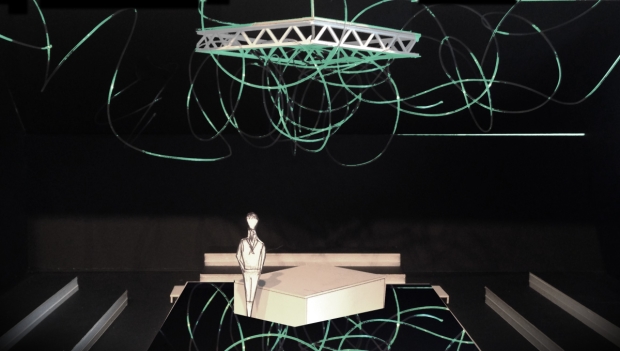Let's talk about sets: Andrew D Edwards on Plaques and Tangles
It’s elemental. A traverse space, a staircase, a bed, lycra walls and an audience. When first reading Plaques and Tangles I was struck by how personal it was and how that familiarity set me up for a stronger fall when the stability of the play is broken. I wanted that for the audience too. For them to feel that they were present in something from the beginning. Megan’s mind in this case.

Working in a studio space is a great tool for this, because it is not a proscenium arch theatre. As a designer I can invite the audience in as a character or element of the production, taking them on a journey into it.
The staircase was the main tool for doing this. The idea was that the audience entered by climbing down it in to the space, past the bed where Megan and Jez were under the duvet. I wanted them to question who are these people? Where are we? Whose story will this be? Practically it also gave other levels to play, with rather than the bare stage.
The idea of keeping the bed onstage throughout the production felt very significant when reading the play. A parent’s bed can be such a pivotal and important place in family life, ‘the kitchen table for upstairs’. Whether it be Christmas mornings, catching up with your partner, conceiving a child, being unwell or even dying. There was a world we found where any of those scenes could come from a bed and it’s where the play begins and ends. I then also considered whether props could come from it. Could it be a workbench, a hay bale, a kitchen table?
I wanted the traverse design and surrounding walls covered in lycra to provide a way to contain the audience and allow the actors to transition in and out of the 35 scenes like memories in Megan’s mind – slipping away as they disappear through the walls. Never stopping or pausing too long to get in the way of the next scene.

It also gave direct contact with fellow audience members. I felt the audience had to be part of the piece and that people’s reaction when watching theatre can be just as important as what is happening on stage. It really makes you think and challenge what you are watching.
The design went through many textures and configurations but at its heart I wanted it to be something the audience could share in and the story could effortlessly emerge from.
Plaques and Tangles is at the Royal Court until 21 November










